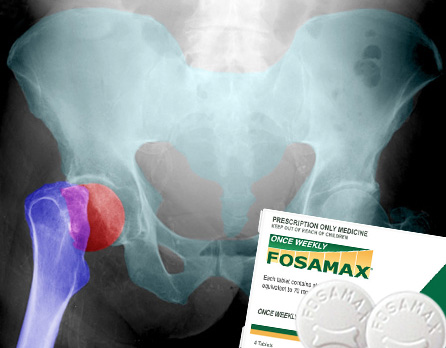Fosamax and Other Bisphosphonates Linked to Higher Chances of Thigh Fractures
July 27, 2012
The use of bisphosphonates may be potentially associated with the incidence of atypical femur fractures, a new study reveals, after having examined a possible link between the intake of a group of bone-sparing drugs and rarely occurring type of fracture that hits the thigh bones. The link between bisphosphonates use and these fractures may be evident, although study authors reportedly declare that the likelihood and extent of the risk continues to be unclear and may still be at a minimum rate.
Categorized within a class of different drugs known as bisphosphonates, this antiresorptive group of medications mainly works by making changes to the bone formation and breakdown cycle in the body, medical experts say. Improving and sustaining bone tissue for strength, and fewer occurrences of fractures are among the reasons these bone-building medications are usually prescribed.
The research team, which has had their research published in the online edition of the Archives of Internal Medication, gathered and analyzed admission radiographs and medical treatment records of over 470 cohorts. The retrospective research reportedly included individuals suffering from fractures between 50 years old and above who were admitted into the University Hospitals of Geneva from 1999 through 2012, and also utilized random samples from 200 healthy individuals who did not suffer or acquire any fractures. Among 477 volunteers, the authors identified 39 people were subtrochanteric fracture patients, while 438 individuals suffered from classic femur fractures. About 82.1 percent of atypical femur fracture patients or 32 people were taking bisphosphonates drugs as treatment, while 6.4 percent or 28 patients suffering from classic femur fractures were under biphosphonate therapy.
After identifying the patients based on the lengths of their treatment, the Sweden-based research team found that the odds for an atypical fracture over a common fracture was 35 to one for treatment of two years or less, 46 to nine for treatment from of two to five years, 117 to one for treatment ranging from five to nine years, and 175 to 7 treatment of more than nine years, all odds reportedly compared to non-treatment.
Biphosphonate drugs that were also involved in the study reportedly included Actonel (risedronate), Aredia (pamidronate), Boniva (ibandronate), and Fosamax (alendronate).
"In conclusion, we have demonstrated that the association between bisphosphonate treatment and the occurrence of atypical fractures of the femur is highly likely and that the duration of such treatment significantly correlates with augmented risk. However, the incidence rate was very low, and the absolute benefit to risk ratio of bisphosphonate use remains positive," concluded the authors.
URL References:
archinte.jamanetwork.com/article.aspx?articleid=1160668
medicalnewstoday.com/articles/245762.php
nature.com/bonekey/community/2012/05/more-data-on-atypical-femoral-fractures-and-bisphosphonate-use/
specialtypharmajournal.com/index.php?option=com_content&view=article&id=3083:bisphosphonate-linked-with-atypical-femur-fractures&catid=346:osteoporosis&Itemid=558
Posted by Philip Quinlan. Posted In : Health